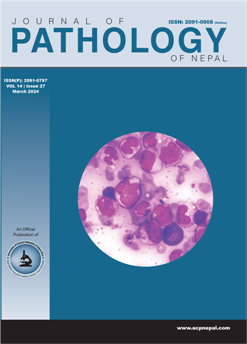Immunohistochemical expression of PD-L1 in esophageal carcinoma and its correlation with histopathological features
DOI:
https://doi.org/10.3126/jpn.v14i1.56916Keywords:
Esophageal carcinoma, Immunohistochemistry, Immunotherapy, PD-L1Abstract
Background: Carcinoma of the esophagus poses a considerable medical and public health challenge in many parts of the world. Despite advances in screening and multimodal management of this disease, overall survival remains poor. There is an utmost need to find a marker for the establishment of targeted immunotherapy. One immunohistochemical marker that has surfaced with the advent of anti-PDL1 immunotherapy is PD-L1 which has been proven to be advantageous. This study aimed to determine PD-L1 expression and its correlation with the grade of tumor and other histopathological parameters in 50 patients.
Materials and Methods: A cross-sectional study was conducted on 50 cases of histopathologically proven esophageal carcinoma. Antibody used for PD-L1 was rabbit monoclonal (CAL10) Biocare. PD-L1 expression was considered positive when a complete or partial membranous or cytoplasmic staining pattern was noted in more than 5% of tumor cells. Correlation between PD-L1 expression and clinicopathological parameters was calculated. Proper consent was taken. The findings of the study were statistically analyzed using Statistical Package for the Social Sciences (SPSS) software version 21.0, a statistical program for Microsoft Windows.
Results: This study revealed that PD-L1 positivity increases as the histopathological grade of esophageal squamous cells increases.
Conclusions: The expression of PD-L1 increases with grade and shows more positive expression in poorly differentiated tumors. This indicates that PD-L1 overexpression is associated with aggressive disease. Targeted therapy against PD-L1 may prove to be beneficial in such patients.
Downloads
Downloads
Published
How to Cite
Issue
Section
License
Copyright (c) 2024 Tarunpreet Saini, Manisha Salwan

This work is licensed under a Creative Commons Attribution 4.0 International License.
This license enables reusers to distribute, remix, adapt, and build upon the material in any medium or format, so long as attribution is given to the creator. The license allows for commercial use.




